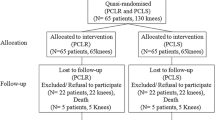Abstract
The purpose of the study was to investigate the results of posterior cruciate ligament (PCL)-retaining total knee arthroplasty (TKA) after previous proximal closed wedge tibial osteotomy for degenerative arthritis according to the technique recommended by Coventry and Insall. Thirty-five patients with previous proximal tibial osteotomy were matched to 35 patients without previous osteotomy according to age, sex, and Knee Society patient category. TKA after osteotomy was technically more difficult, often requiring a more extensive exposure. Complications were similar in the two groups, but an extended hematoma was more common in patients with previous osteotomies (2 patients) than in those with primary arthroplasty (1 patient). Knee Society scores were significantly lower in those with previous osteotomy, primarily because of decreased anteroposterior stability and pain. No significant differences were found in function scores, range of motion, or alignment. However, overall results of this PCL-retaining unconstrained TKA did not match those reported after PCL-substituting TKA.
Similar content being viewed by others
Author information
Authors and Affiliations
Additional information
Received: 8 March 1999
Rights and permissions
About this article
Cite this article
Walther, M., König, A., Kirschner, S. et al. Results of posterior cruciate-retaining unconstrained total knee arthroplasty after proximal tibial osteotomy for osteoarthritis . Arch Orth Traum Surg 120, 166–170 (2000). https://doi.org/10.1007/s004020050036
Issue Date:
DOI: https://doi.org/10.1007/s004020050036




